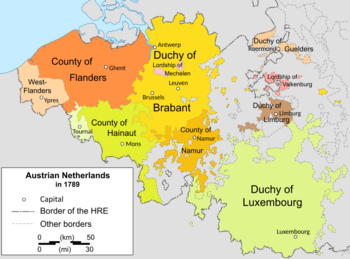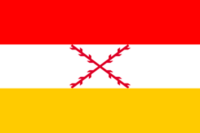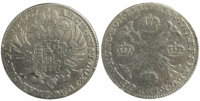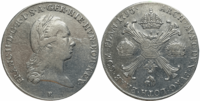Austrian Netherlands facts for kids
Quick facts for kids
Austrian Netherlands
|
|||||||||||
|---|---|---|---|---|---|---|---|---|---|---|---|
| 1714–1797 | |||||||||||
|
|
|||||||||||

The Austrian Netherlands in 1789
|
|||||||||||
 |
|||||||||||
| Status | Personal union of Imperial fiefs within Empire | ||||||||||
| Capital | Brussels | ||||||||||
| Common languages | |||||||||||
| Religion | Roman Catholic | ||||||||||
| Government | Governorate | ||||||||||
| Governor | |||||||||||
|
• 1716–1724 (first)
|
Eugene Francis | ||||||||||
|
• 1793–1794 (last)
|
Charles Louis | ||||||||||
| Plenipotentiary | |||||||||||
|
• 1714–1716 (first)
|
Lothar Dominik | ||||||||||
|
• 1793–1794 (last)
|
Franz Karl | ||||||||||
| Habsburg | |||||||||||
| Bourbon | |||||||||||
| Historical era | Early modern | ||||||||||
| 7 March 1714 | |||||||||||
|
• Treaty of Fontainebleau
|
8 November 1785 | ||||||||||
| 1789–1790 | |||||||||||
|
• Battle of Sprimont
|
18 September 1794 | ||||||||||
| 17 October 1797 | |||||||||||
| Currency | Kronenthaler | ||||||||||
|
|||||||||||
| Today part of | |||||||||||
The Austrian Netherlands was a region in Europe that existed from 1714 to 1797. It was part of the Holy Roman Empire, a large group of states in Central Europe. This period started when Austria, led by the Habsburg monarchy, took control of lands that used to be the Spanish Netherlands. This happened after a peace agreement called the Treaty of Rastatt in 1714.
The Austrian Netherlands lasted until 1794. At that time, Revolutionary France took over the area after a battle. Austria officially gave up its claim to these lands in 1797 with the Treaty of Campo Formio.
Contents
History
A long conflict called the Eighty Years' War (1568–1648) divided the Low Countries. This area is now modern-day Belgium, Luxembourg, and the Netherlands. The northern part became the independent Dutch Republic. The southern part, which included the Austrian Netherlands, later became Belgium and Luxembourg.
The Habsburg family had ruled this southern area for a long time. However, it was briefly controlled by the Bourbon family during the War of the Spanish Succession. After this war ended, the Treaty of Rastatt in 1714 gave the remaining Spanish Netherlands to Austria. The region was divided into different areas like duchies and counties.
Brabant Revolution
In the 1780s, people in the Austrian Netherlands became unhappy. Emperor Joseph II introduced new rules that many saw as attacks on their traditions. These rules also affected the Catholic Church, which was very important to them.
Resistance grew, especially in the wealthy regions of Brabant and Flanders. In 1787, there were riots and unrest, known as the Small Revolution. Many people who opposed the Emperor's rules fled to the nearby Dutch Republic. There, they formed a rebel army.
Soon after the French Revolution began, this rebel army entered the Austrian Netherlands. They won a big victory against the Austrians at the Battle of Turnhout in October 1789. With support from uprisings across the region, the rebels quickly took control. They declared their independence, forming the United Belgian States in January 1790.
However, this new country faced problems. It didn't get support from other countries. Also, the rebels themselves disagreed on how to govern. One group, the Vonckists, wanted a more modern and open government. The other group, the Statists, wanted to keep old traditions and were supported by the Church. The Statists had more public support and forced the Vonckists to leave.
By mid-1790, Austria finished its war with the Ottoman Empire. The new Emperor, Leopold II, offered to forgive the rebels. After defeating a Statist army, Austria quickly took back control by December.
However, Austrian rule didn't last long. In 1794, during the War of the First Coalition, the French army took over the territory. This happened after the Battle of Fleurus.
French Rule
In 1794, the Austrians decided not to fight for the Low Countries anymore. They left the region to the French after the Battle of Fleurus on June 26. For three months, the French military occupied the area.
On October 15, a new French administration was set up. On October 1, 1795, France officially took over the Austrian Netherlands. They made it part of the French Republic. The old Belgian governing council was dissolved. By January 20, 1797, there was no longer any common Belgian authority.
See Also






